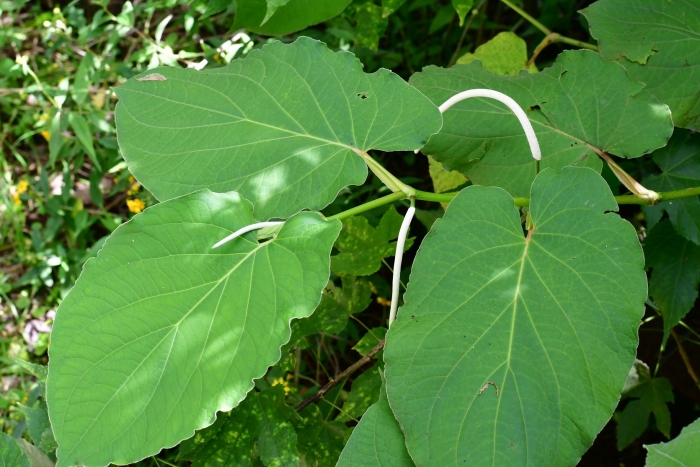Hoja Santa
(Piper auritum)
Hoja Santa (Piper auritum)
/
/

Neptalí Ramírez Marcial
CC BY 4.0
Image By:
Neptalí Ramírez Marcial
Recorded By:
Copyright:
CC BY 4.0
Copyright Notice:
Photo by: Neptalí Ramírez Marcial | License Type: CC BY 4.0 | License URL: http://creativecommons.org/licenses/by/4.0/ | Rights Holder: Neptalí Ramírez Marcial | Publisher: iNaturalist | Date Created: 2021-09-16T11:03:33-07:00 |

























Estimated Native Range
Summary
Piper sanctum, commonly known as Hoja Santa, is a perennial herb native to the warm and humid regions of Central and South America, particularly in the understory of tropical rainforests. It can grow up to 6 feet (1.8 meters) in height and width, with a bushy appearance. The plant is characterized by its large, heart-shaped, velvety leaves that can reach up to 12 inches in length and emit a distinctive aroma with notes of eucalyptus, licorice, and pepper when crushed. The leaves are a deep green color, and the plant also produces small, inconspicuous white flowers during the summer months.
Hoja Santa is valued for its culinary uses in Mexican cuisine, where the leaves are often used to wrap foods such as tamales and fish, imparting a unique flavor to the dishes. It is also a key ingredient in mole verde and other traditional recipes. In cultivation, Piper sanctum prefers a warm, humid environment with partial shade, similar to its native habitat. It requires consistently moist soil with good drainage. While it is not particularly prone to diseases, it can be sensitive to cold temperatures and may need protection in cooler climates. Due to its rapid growth and spreading habit, it can become invasive outside its native range, so gardeners should be cautious and check local regulations before planting.CC BY-SA 4.0
Hoja Santa is valued for its culinary uses in Mexican cuisine, where the leaves are often used to wrap foods such as tamales and fish, imparting a unique flavor to the dishes. It is also a key ingredient in mole verde and other traditional recipes. In cultivation, Piper sanctum prefers a warm, humid environment with partial shade, similar to its native habitat. It requires consistently moist soil with good drainage. While it is not particularly prone to diseases, it can be sensitive to cold temperatures and may need protection in cooler climates. Due to its rapid growth and spreading habit, it can become invasive outside its native range, so gardeners should be cautious and check local regulations before planting.CC BY-SA 4.0
Plant Description
- Plant Type: Shrub, Tree, Herb
- Height: 4-10 feet
- Width: 3-10 feet
- Growth Rate: Moderate, Rapid
- Flower Color: N/A
- Flowering Season: Spring, Summer, Fall
- Leaf Retention: Evergreen
Growth Requirements
- Sun: Full Sun, Part Shade
- Water: Medium
- Drainage: Medium
Common Uses
Edible*Disclaimer: Easyscape's listed plant edibility is for informational use. Always verify the safety and proper identification of any plant before consumption., Fragrant, Low Maintenance, Potted Plant
Natural Habitat
Understory of tropical rainforests in Central America
Other Names
Common Names: Hoja Santa, Sacred Pepper, Mexican Pepperleaf, Vera Cruz Pepper, Ear-Leaf Pepper, Root Beer Plant
Scientific Names: , Piper auritum, Artanthe aurita, Artanthe sancta, Artanthe seemanniana, Piper alstonii, Piper auritilaminum, Piper auritilimbum, Piper auritum var. amplifolium, Piper auritum var. schiedeanum
GBIF Accepted Name: